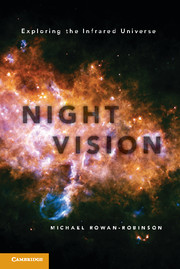Book contents
- Frontmatter
- Contents
- Preface
- 1 Introduction
- 2 William Herschel Opens Up the Invisible Universe
- 3 1800–1950
- 4 Dying Stars Shrouded in Dust and Stars Being Born
- 5 Birth of Submillimetre Astronomy
- 6 The Cosmic Microwave Background, Echo of the Big Bang
- 7 The Infrared Astronomical Satellite and the Opening Up of Extragalactic Infrared Astronomy
- 8 The Cosmic Background Explorer and the Ripples, the Wilkinson Microwave Anisotropy Probe and Dark Energy
- 9 Giant Ground-Based Near-Infrared and Submillimetre Telescopes
- 10 The Infrared Space Observatory and the Spitzer Space Telescope
- 11 Our Solar System’s Dusty Debris Disk and the Search for Exoplanets
- 12 The Future
- Epilogue
- Notes
- Credits for Illustrations
- Glossary
- Further Reading
- Bibliography
- Name Index
- Subject Index
4 - Dying Stars Shrouded in Dust and Stars Being Born
The Emergence of Infrared Astronomy in the 1960s and 1970s
Published online by Cambridge University Press: 05 March 2013
- Frontmatter
- Contents
- Preface
- 1 Introduction
- 2 William Herschel Opens Up the Invisible Universe
- 3 1800–1950
- 4 Dying Stars Shrouded in Dust and Stars Being Born
- 5 Birth of Submillimetre Astronomy
- 6 The Cosmic Microwave Background, Echo of the Big Bang
- 7 The Infrared Astronomical Satellite and the Opening Up of Extragalactic Infrared Astronomy
- 8 The Cosmic Background Explorer and the Ripples, the Wilkinson Microwave Anisotropy Probe and Dark Energy
- 9 Giant Ground-Based Near-Infrared and Submillimetre Telescopes
- 10 The Infrared Space Observatory and the Spitzer Space Telescope
- 11 Our Solar System’s Dusty Debris Disk and the Search for Exoplanets
- 12 The Future
- Epilogue
- Notes
- Credits for Illustrations
- Glossary
- Further Reading
- Bibliography
- Name Index
- Subject Index
Summary
Pioneers Working from Mountaintops
In this chapter, I describe how pioneers working from mountaintops discovered new types of infrared stars, which turned out to be either dying stars shrouded in dust or stars in the process of being born. The leaders of this infrared revolution were the Americans Frank Low (1933–2009) and Gerry Neugebauer (b.1932). First efforts to map the sky with telescopes on balloons and rockets began the push to observe at longer wavelengths inaccessible from the ground. And theorists began to use the observed distributions of brightness with wavelength in the new infrared sources to model the distribution and properties of the interstellar dust in clouds around stars and spread through interstellar space.
The first pioneer of the modern age of infrared astronomy was Harold Johnson (1921–1980) (Figure 4.1). He and his group, then at the University of Texas at Austin, began in the late 1950s to work with lead sulphide detectors, which they cooled with liquid nitrogen to 77 K (−196 °C). Cooling made the detectors much more sensitive, and over the next few years Johnson’s group observed several thousand stars. Johnson had earlier defined the standard optical observing bands, which are denoted U (ultraviolet), B (blue), V (visual), R (red) and I (infrared).
- Type
- Chapter
- Information
- Night VisionExploring the Infrared Universe, pp. 35 - 58Publisher: Cambridge University PressPrint publication year: 2013



